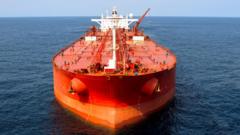Global oil prices have experienced a notable surge following Israeli airstrikes targeting Iran, marking a significant escalation in tensions within the Middle East. The benchmark Brent crude oil price surged by over 10% upon the announcement of the strikes, reaching its highest levels since January. Traders are increasingly wary of the possibility that a broader conflict could disrupt oil supplies from this historically volatile region, which is essential for energy markets worldwide.
Following the initial spike in prices, Brent crude settled around 5% higher than its closing price on Thursday, trading at approximately $74.47 per barrel. Nevertheless, these prices remain over 10% lower than the levels observed at the same time last year and fall significantly below the peaks experienced in early 2022, following Russia's invasion of Ukraine, which saw crude prices soar past $100 a barrel.
As oil prices climbed, stock markets across Asia and Europe responded negatively, with Japan's Nikkei index losing 0.9% and the UK's FTSE 100 index dropping by 0.3%. This downward trend carried over to the US markets, where the Dow Jones Industrial Average fell by 1.5%, and the S&P 500 dropped by 0.8%. Conversely, so-called "safe haven" assets like gold and the Swiss franc saw increased demand, with gold prices rising 1.2% to $3,423.30 per ounce.
In response to the strikes, the Israeli Defense Forces (IDF) reported that Iran had launched approximately 100 drones towards Israel, intensifying fears of escalating hostilities. Analysts are cautioning that while this situation could quickly ease as seen in previous years, it also has the potential to spiral into a broader conflict that could heavily disrupt oil supplies in the Middle East.
Vandana Hari from Vanda Insights noted that energy traders will closely monitor the situation for potential escalation. Other analysts, such as those from Capital Economics, have indicated that should Iranian oil production and export facilities be targeted, prices could rise to between $80 and $100 per barrel. However, they also suggested that such price increases could prompt other oil-producing nations to ramp up production, limiting sustained price hikes.
Rod Dennis from the UK motoring body the RAC emphasized that it is premature to determine the impact of rising oil prices on petrol costs. He identified two critical factors: whether current wholesale prices persist in the days ahead and the pricing strategies adopted by fuel retailers.
The deeper implications of this conflict could involve potential disruption of millions of barrels of oil daily if Iran opts to target critical infrastructure or disrupt shipping routes in the strategically vital Strait of Hormuz. Currently, this strait is crucial for the passage of about one-fifth of the world's oil supplies. Market analysts suggest that the market's initial reactions may evolve as clarity on the extent of the conflict emerges in the upcoming days.



















